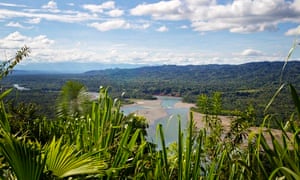China’s Amazonian railway ‘threatens uncontacted tribes’ and the rainforest

Chinese premier Li Keqiang is to push controversial plans for a railway through the Amazon rainforest during a visit to South America next week, despite concerns about the possible impact on the environment and on indigenous tribes.
Currently just a line on a map, the proposed 5,300km route in Brazil and Peru would reduce the transport costs for oil, iron ore, soya beans and other commodities, but cut through some of the world’s most biodiverse forest.
The six-year plan is the latest in a series of ambitious Chinese infrastructure projects in Latin America, which also include a canal through Nicaragua and a railway across Colombia. The trans-Amazonian railway has high-level backing. Last year, President Xi Jinping signed a memorandum on the project with his counterparts in Brazil and Peru. Next week, during his four-nation tour of the region starting on Sunday, Li will, according to state-run Chinese media, suggest a feasibility study.
Starting near Açu Port in Rio de Janeiro state, the proposed track would connect Brazil’s Atlantic coast with Peru’s Pacific coast, via the states of Goiás, Mato Grosso and Rondônia.
The logistical challenges are considerable because the line will pass through dense forest, swamps and then either desert or mountains (there are two options for the Peruvian end of the route), as well as areas of conflict between tribes and drug traffickers.
Near the Bolivian border, it will come close to the “Devil’s Railway”, an ill-fated link built in 1912 between Porto Velho in Brazil and Guajará-Mirim in Bolivia. It cost 6,000 lives and was barely used after the collapse of the rubber industry.
Financing is likely to come from the China Development Bank, with construction carried out by local firms and the China International Water and Electric Corporation. China’s involvement is partly explained by a desire to reduce freight costs, but it also hopes to create business for domestic steel and engineering firms that have been hit by the slowdown of the Chinese economy.
China is playing an increasing role in Latin America, having tripled its share of regional exports in the past decade – particularly of food and minerals. But there is a considerable cost in terms of environmental degradation and social conflict, according to a recent Boston University study. Although major Chinese firms have put in place improved guidelines, conservationists and campaigners for indigenous rights fear this project will continue that trend by carving up nature reserves, crossing the land of uncontacted tribes and opening up indigenous land for development. This is expected to prompt an outcry.
“This project is iconic and is likely to become centre-stage for Latin American civil society organisations,” said Paulina Garzon, director of the China-Latin America Sustainable Investment Initiative. “It is way too big to pass unnoticed, and … will be tremendously controversial on both environmental and social fronts: first because of its size and location but also because Latin-American environmental groups and indigenous organisations are quite vocal and very well-networked.”
She said planners needed to avoid the mistakes of past megaprojects, which rushed or avoided environmental impact assessments and consultations with local people.
“It would be smart to establish a robust and meaningful multi-stakeholder consultation from the very beginning,” she said.
For environmentalists, the main areas of concern are the Isconahua Reserve and Vale do Rio Juruá, which is home to one of the most spectacular ranges of flora and fauna on the planet. The route also crosses some of the last large tracts of standing forest in Mato Grosso, Rondônia and Acre, as well as indigenous and protected areas in the Amazon.
Earlier infrastructure developments, such as the Trans-Amazonian Highway, the Belo Monte dam and the Carajás open-cast mine were pushed through with scant consideration for the impact on nature and local people.
“Past mega-projects suggest that far from consulting the indigenous communities that lay in their path, the government is more likely to steamroll their rights while paying mere lip service to environmental protection,” said Christian Poirier of Amazon Watch. “As with road projects, railways open access to previously remote regions, bring a flow of migrant workers inevitably followed by deforestation mafias and cattle ranchers, creating a perfect storm of pressures upon the forest and forest peoples.”
Nilo D’Ávila of Greenpeace said an alternative to road transport may be a good thing, but only if the operators strictly followed conservation regulations and did not use the railway as a precursor to more resource extraction.
“The good part is that it’s an investment in a different mode of transport. But it seems to follow mining logic – first you build a road, then a hole,” he said. “They need to guarantee it can be built without causing problems.”
Precedents give little reason to hope that will be the case.







Follow Us!